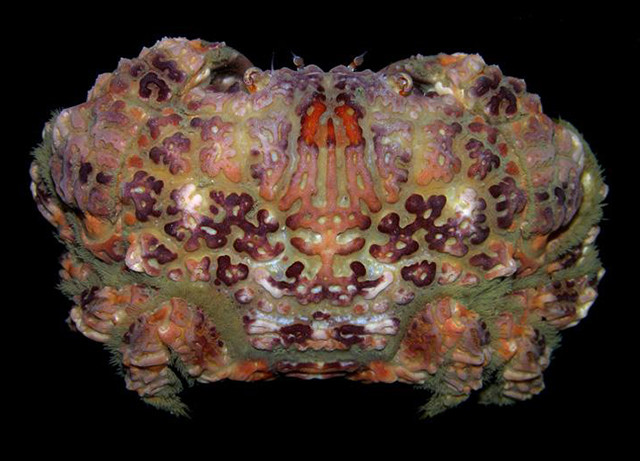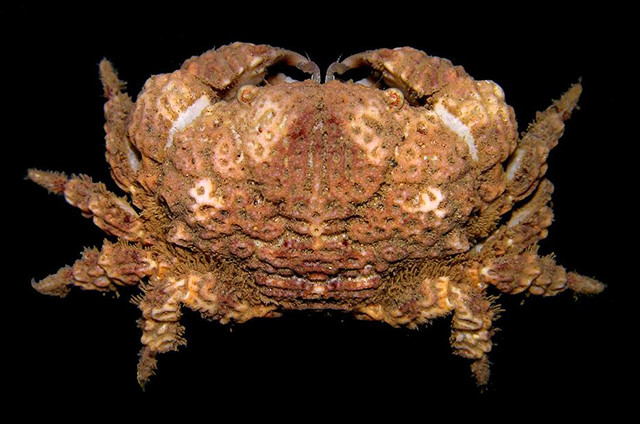Labyrinth crab, Glyptoxanthus labyrinthicus (Stimpson, 1860)
By Arthur Anker
The labyrinth crab, Glyptoxanthus labyrinthicus (Stimpson, 1860), is one of 8 species in the genus Glyptoxanthus A. Milne Edwards, 1859, which belongs to one of the largest families within the order Decapoda, the crab family Xanthidae. This peculiar crab lives in the rocky intertidal and shallow subtidal areas of the tropical Eastern Pacific, from Mexico south to Panama and the Galapagos Archipelago. It is a medium-sized crab, the carapace of the largest individuals reaching 35 mm or so in width (carapace width is a standard measurement for crabs).

Despite its fairly extensive distribution, noticeable size and occurrence in relatively accessible intertidal habitats, the labyrinth crab is rarely collected. Not only because it is uncommon, but also because it is remarkably camouflaged. With its dorsally flattened, intricately sculptured, labyrinth-like carapace (photo 1), G. labyrinthicus indeed resembles an eroded rock or piece of rubble more than a crab. The crab’s stout, short claws may be held close to, while the walking legs may be folded under the carapace, making them invisible in dorsal view and enhancing its resemblance to a rock. In addition, both claws and walking legs are channelled and grooved and also appearing “eroded”. The red-purple-whitish marbling contributes to the overall disguise resembling red-purple coralline algae that encrusts many rocks. The biology of the labyrinth crab is almost completely unknown. Based on my field observations, G. labyrinthicus is a docile, non-aggressive, relatively slow-moving crab. It probably feeds opportunistically on detritus and algae as well as small invertebrates such as molluscs and worms.
The genus Glyptoxanthus has a worldwide distribution and currently includes 8 species. The Florida eroded crab, Glyptoxanthus erosus (Stimpson, 1859), originally described from Florida is known from numerous localities in the tropical and subtropical Western Atlantic (Bahamas, Gulf of Mexico, Caribbean). The American vermiculated crab, G. vermiculatus (Lamarck, 1818) was originally described by Jean-Baptiste Lamarck on the basis of a specimen of unknown origin. Lamarck’s dried type specimen of G. vermiculatus, now almost 200 years old, is kept in the Muséum national d’Histoire naturelle in Paris (MNHN), according to Rathbun (1930). This species is known from several localities on the northern and eastern coast of South America (Curaçao, Venezuela, Guyana, Brazil). The African vermiculated crab, G. angolensis (Brito Capello, 1866) (photo 2) is known only from Angola and the Gulf of Guinea islands in the Eastern Atlantic; it is almost identical morphologically to G. vermiculatus. The Hancock’s labyrinth crab, G. hancocki Garth, 1939, described from Galapagos, is closely related to G. labyrinthicus and can be easily confused with the latter species. On the other hand, the hairy eroded crab, G. meandricus (Klunzinger, 1913) from the Red Sea, is more distinct, being covered with short stiff setae.

All species of Glyptoxanthus appear to be uncommon. The FLMNH Crustacea collection currently holds 2 specimens of this interesting genus: 1 specimen of G. labyrinthicus from Panama and 1 specimen preliminarily identified as G. cf. angolensisfrom São Tomé. Please contact us if you come across any “eroded-looking” crab, especially on the coasts of Florida.